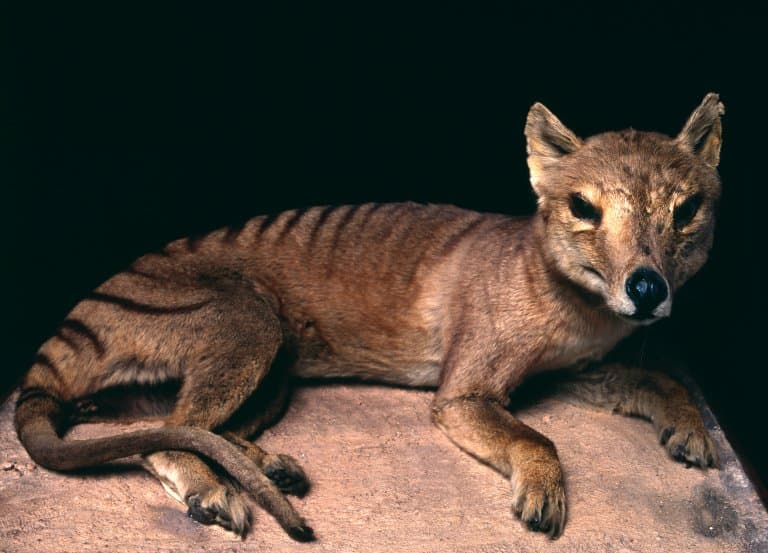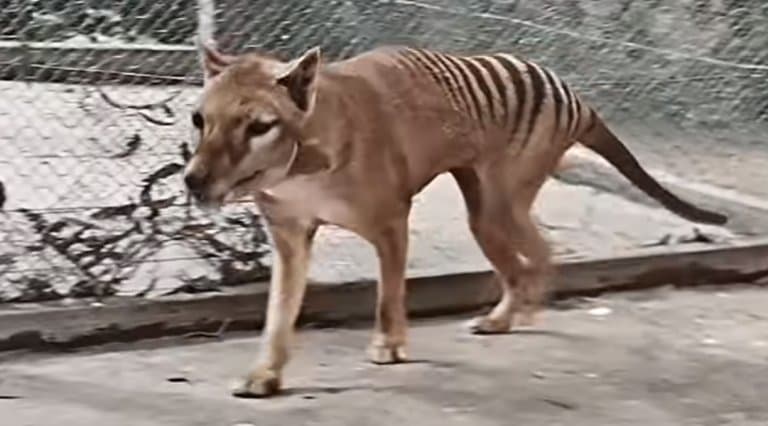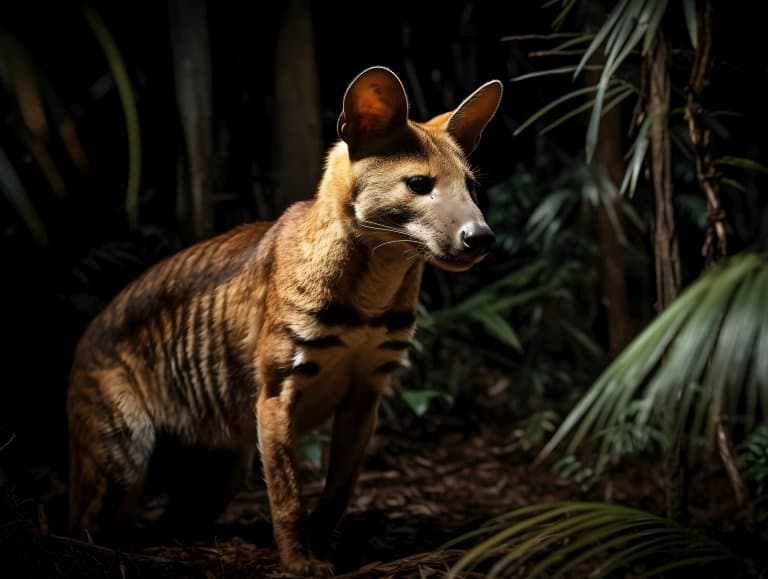Thylacine Profile
Of all the large marsupial carnivores, only one was able to withstand the combined effects of human destruction and climate change all the way up to the 1930s. Some say it may even still exist. A nocturnal stalker with stripes and a long, toothed jaw that used to patrol the jungles of Australia.
Sadly, the last footage we have of a live one comes from a captive animal that died in 1930, but the hunt for a wild one is still on.
The thylacine, also known as the Tasmanian tiger, or Tasmanian wolf, is an extinct marsupial with the appearance of a medium sized canid that was native to Australia, Tasmania and New Guinea.

Thylacine Facts Overview
| Habitat: | Woodlands and coastal heath |
| Location: | Australia, Tasmania, New Guinea |
| Lifespan: | Up to 9 years in captivity |
| Size: | 1.3m (51 inches) long, 65cm (26 inches) tall. |
| Weight: | Probably up to 30kg (66lb) |
| Color: | Tan with black stripes at the rear |
| Diet: | Mostly ground birds |
| Predators: | Humans |
| Top Speed: | Unknown |
| No. of Species: | 1 |
| Conservation Status: | Extinct (IUCN) |
The extinct thylacine sparks mystery and excitement across popular culture, and they are an icon throughout Australia.
The thylacine inhabited forests, wetlands, and grasslands and spent its daylight hours in caves or hollow tree trunks.
They were a nocturnal hunter and carnivorous, with a preference to dieting on birds, such as chickens and Tasmanian nativehens. They may have also preyed upon bandicoots and possums.
The combination of thousands of witness testimonies and plenty of wishful thinking makes it one of the hottest topics in Tasmanian conservation right now.
Could there still be hidden populations out there in the inaccessible and vast forests of Australia’s biggest island?
Interesting Thylacine Facts
1. They are not a tiger, and don’t really look like one either
The Thylacine, also known as the Tasmanian Tiger, was not a tiger. In fact, it was separated from tigers by 160 -100 million years.
It doesn’t even look like a tiger. It’s as much a tiger as a zebra is a tiger, in that it has stripes, except a zebra is even closer to a tiger, sharing a common ancestor a mere 85 million years ago. The common name was brought in by the British colonists, and we all know what they were like.
It looks a lot more like a dog than a tiger anyway, but it wasn’t a dog either! It’s a marsupial, having evolved in isolation from the placental mammals, on a remote island off the coast of Australia.
But don’t let that mislead you, Tasmania looks small on the map because it’s sitting next to the largest island in the world. Tasmania itself is still pretty big – around the size of Ireland – and this will become important later on.
As a marsupial, the Thylacine had a pouch that it would carry and develop its young inside. Even the males had a pouch, which was used as a protective sheath for the genitals.

2. Humans hunted them to extinction
Thylacines, like many other large, extinct marsupials were once prevalent in both mainland and Tasmanian forests, as well as in New Guinea.
British colonial presence brought with it a certain bloodlust for hunting anything with teeth that might compete with livestock farming.
In Tasmania, as the media is inclined to do, tabloids whipped up a thylacine-frenzy, claiming vast numbers of sheep deaths caused by the predatory marsupial; in some cases more than there were sheep on the island.
Ultimately, hunting thylacine became something that was rewarded in cash by the government, and the species rapidly declined from 5,000 to, probably zero.
Disease played a role too, as did the introduction of a competitor, the dingo. The reputation of Thylacines as an enemy even went as far as rumours about it drinking blood.
The species was declared protected in 1938, several years after the last known individual in the wild individual had been shot, and only two months before the last captive one died.
Since then, none have ever been recorded.
3. They had some unique characteristics
The Tasmanian tiger was an apex predator and had a couple of quite unique adaptations.
They could open their jaw to an unusual extent of 80 degrees. While they look more like a dog, or a fox, they had very stiff straight tails – more like a kangaroo.
They would also perform a bipedal hop occassionally, again similar to a kangaroo.
Both of which are captured in the video below.
3. They might have lived for longer than we realised
There’s a small community of Thylacine fans who firmly hold that it still exists.
An even larger and slightly more credible group suggest the extinction window reaches well into the ‘80s, and perhaps as late as the 2000s.
There are different levels of evidence to back up these claims, none of which are enough to convince the scientific community just yet, though. 1
4. There are many alleged witness accounts of sightings
Thylacine footprints are very distinctive, and there have been reports of such prints on the trail, yet no photographs to support them.
But there are literally thousands of personal witness accounts, many of which were collected and matched against the credibility of the person reporting it, giving what some are leaning on as credible evidence to suggest a much later window of extinction and even the possibility that a few individuals remain somewhere in the dense Eucalyptus forests. 2
5. Parasites
When a species dies, usually its host-specific entourage of parasites dies off with it. But there’s at least one parasite, a burrowing flea, that remains in circulation in Tasmania.
This flea was a well-known parasite of the thylacine, and while it’s making do with other, less suitable marsupial hosts, its continued existence may suggest that it is either still in contact with or has only recently lost access to, its Thylacine host.
This is still all very weak evidence for a claim, but one of the major hurdles in investigating the subject is the sheer size of the operation. 3
6. Tasmania is large
As mentioned, it’s the size of Ireland, with roughly 70% forest cover and a tenth of the population. It’s not easy to scour this amount of land for an elusive marsupial that doesn’t want to be found.
Further, Thylacines were nocturnal hunters and notoriously shy animals, so finding one would involve immense amounts of funding and lots of cameras.
The lack of human access to its habitat is not evidence of the Thylacine’s continued exitance, by any means, but if it were to exist, it’s certainly possible that very few people would ever find it.
7. It’s unlikely to still exist
As with other legendary creatures like the Loch Ness monster or Bigfoot, there’s a powerful incentive of wonder and excitement (not to mention a $100,000 reward for evidence and a $1.75m reward for its capture) that sits behind a lot of witness reports, and the aggregation of them by wishful-thinking researchers.
Science can only prove positives; no amount of research funding can rule out a secret, hidden population of plesiosaurs in Scotland, hairy, bipedal ape-men in North America, or a small family of Thylacines in Tasmania.
And people will always take advantage of this loophole to make assumptions, accurately or not. That’s not to say witness accounts should be ruled out automatically, and some are certainly more convincing than others.
As it stands, there is very little, if any, viable evidence to conclude that Thylacines still roam about, as much as it would be wonderful to discover. But that doesn’t mean there never will be.

8. But we might bring it back anyway
The company Colossal, which is known for its drive to bring back the Wooly Mammoth, are also gathering funds to de-extinct the thylacine.
Using a surrogate from its closest living relative, the Dunnart, scientists think they can edit enough of the Dunnart’s genes to match Thylacine DNA found in museum samples.
If all goes to plan, gene editing might be the new frontier of conservation, able to undo some of the vast carnage our species has inflicted on other animals all over the world, including the enigmatic and mysterious Thylacine. 4
Thylacine Fact-File Summary
Scientific Classification
| Kingdom: | Animalia |
| Phylum: | Chordata |
| Class: | Mammalia |
| Order: | Dasyuromorphia |
| Family: | Thylacinidae |
| Family: | Thylacinus |
| Family: | Thylacinus Cynocephalus |
Fact Sources & References
- James Fair (2021),“Study suggests the Tasmanian tiger survived into the 21st century”, Mongabay.
- “Tasmanian tiger may have survived into the 2000s, new analysis suggests”, The Guardian.
- Aristos Georgiou (2023), “Parasites That Feasted on Extinct Tasmanian Tiger Still Exist: ‘Remarkable’”, Newsweek.
- “Back from extinction: Resurrecting the Tasmanian tiger”, Aljazeera.
